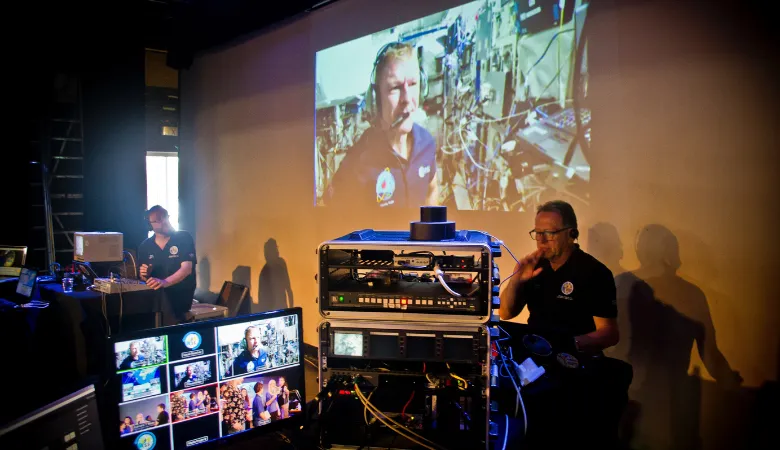03 June 2024
Meet... Frank Heritage
We chatted with 'Star Man' Frank Heritage about how he uses his Service Time to contact the International Space Station.

In this interview, Frank Heritage, Digital Experience Lead for the Faculty of Life Sciences & Medicine, tells us all about how he uses his Service Time to volunteer at a school to help them make contact with astronauts onboard the International Space Station.
Hi Frank, could you tell us a bit more about the work you do with the King’s staff service time?
I've recently been involved in two days of voluntary service with a school in Devon, helping to provide the ground link for an amateur radio contact between the school and an astronaut on the International Space Station, through the ARISS programme. I look after the audio visual in the school (usually with most of the school watching in the main hall), and feed the live stream of the event for the rest of the world to follow along.
Wow! That must have been incredibly exciting for all involved. Did you ever manage to reach them?
Yes! This was a very successful contact with all twenty questions from the students being asked (there’s not always time for all the questions), and very clear audio back from the ISS. Full details about the contact can be found on the AMSAT-UK page and a video from the contact can be viewed on the ARISS YouTube channel.
For a radio ham, what were the biggest challenges in making the connection work?
The space station moves at over 17,000 miles per hour, and the contact is on the VHF radio band, meaning directional aerials need to track the space station across the sky. In addition, doppler shift means your frequency is constantly changing... and to top it all off, the ISS is only visible above the horizon for about 10 minutes in any one pass – so there’s no room for error!

What was the reaction of the children? Did they ask any stellar questions?
The reaction of the pupils is always fantastic! It’s something they’ll remember for a very long time – it's not every day your school gets to speak with an astronaut – in space! The questions are always very imaginative; some of the best from this contact: “If you can make the water from a bottle float, then how can you swallow it without it coming up again?”
And: “Why doesn’t the ISS fall and hit the ground?”
But the team’s favourite question came from a sixth form student in Norwich at a previous contact: “Does NASA have a protocol if there’s a knock on the door (airlock), and which member of the crew do you send to answer it?”
The astronauts have the questions in advance - emailed to them! - so they can answer them quickly and succinctly... it also helps if there's noise on the signal and they don't quite hear it. No need for a repeat.
Our team leader had the phone number for Tim Peake (in space) on his phone, and immediately after we finished the first schools contact, Tim rang him from the space station to check how well it had gone from our end! There’s no escape from modern communications!
How did you get involved in that?
I’ve been a radio amateur for forty years, after being introduced to it when I was in the Scouts – and I’ve always had an interest in satellite communication. When the team was being put together to support Tim Peake’s Principia mission in 2016 on the Space Station, I was asked if I’d like to assist with my video and audiovisual skills – the team already had some very experienced space communications members with a lot more knowledge than me. We provided contact between eleven UK schools and Tim in the six months he was on the Space Station and streamed them live to the web. The team still assist with contacts with the ISS for UK schools once or twice a year.
All the contacts are available to watch on the ARISS UK YouTube channel.
When you’re not boldly going where no King’s employee has been before, tell us a bit about your day job
I’ve been the Digital Experience Lead for the Faculty of Life Sciences & Medicine for three years. Every day is different – from creating and updating people profiles for the website, to highlighting the amazing work being undertaken by our Research Groups by looking after their pages on our website. With over 1,300 web pages just for the Faculty, it’s certainly the largest website I've been involved with, and it’s always a challenge to ensure the visitor has the best experience whilst finding the information they’re looking for.
In addition to the website, I also assist the Communications Team in the Faculty with live events, like our All-Staff Forum and our Faculty Staff Awards. With thirty years experience as a graphic designer, it’s great to be able to bring my skills in Photoshop and InDesign to the team as well.
Who inspires you most and why?
Whilst at art college we had a visit and lecture from Abram Games, who designed many recruitment posters for the forces during WW2 and afterwards for many major events – like the Festival of Britain. His style was minimalist, but beautifully executed and I still find inspiration in his designs.
